|
|
 |
|
Calanoida ( Order ) |
|
|
|
Clausocalanoidea ( Superfamily ) |
|
|
|
Scolecitrichidae ( Family ) |
|
|
|
Racovitzanus ( Genus ) |
|
|
| |
Racovitzanus antarcticus Giesbrecht, 1902 (F,M) | |
| | | | | | | Syn.: | Racovitzanus erraticus (M) Vervoort, 1957 (p.99, figs.M); Minoda, 1971 (p.32, 50); 1972 (p.326); no R. antarcticus (M) : Vervoort, 1957 (p.97, figs.M);
? Scolecithricella porrecta : Wilson, 1942 a (p.208, figs.F, ? juv.M) | | | | Ref.: | | | Giesbrecht, 1902 (p.26, figs.F); Wolfenden, 1911 (p.259, figs.F, Rem.); Brady, 1918 (p.23, figs.M); Farran, 1929 (p.209, 250); 1936 a (p.95); Brodsky, 1950 (1967) (p.267, figs.F); Vervoort, 1951 (p.94, Rem.); 1957 (p.97, figs.F); Tanaka, 1960 (p.41, figs.F, juv.M); Park, 1970 (p.70, 71: Rem.); Minoda, 1971 (p.31, Rem.); Bradford, 1971 b (p.22, figs.F,M, Rem.); Dawson & Knatz, 1980 (p.6, figs.F); Björnberg & al., 1981 (p.639, figs.F); Gardner & Szabo, 1982 (p.296, figs. F,M); Schnack, 1982 (p.149, fig.Mx); Bradford al., 1983 (p.91, Rem. F, M, figs. F, M); Park, 1983 (p.171, 172, 177, Redescr. F,M, figs.F, M, Rem.); Razouls, 1994 (p.111, figs.F,M); Chihara & Murano, 1997 (p.899, Pl.168,170: F,M); Markhaseva & Dahms, 2004 (Rem.: p.336); Vives & Shmeleva, 2007 (p.817, figs.F,M, Rem.); Sedova & Grigoryev, 2011 (p.532, morphologic variation) |  Issued from : J.M. Bradford, L. Haakonssen & J.B. Jillett in Mem. N.Z. oceanogr. Inst., 1983, 90. [p.92, Fig.53]. Female: A, habitus (lateral left side); B, rostrum; C, Mx2; D, endopod of P2; E, P5. Male (from Ross Sea): F, P5. Nota Female: - Pediger segments 4 and 5 fused. - Rostrum sausage-shaped, with 2 fine, short terminal filaments. - Posterolateral corners of last thoracic segment slightly produced, ending in point. - Genital segment swollen ventrally and as long as combined length urosomal segments 2 and 3 and 2/3 of segment 4. - Urosome segment 4 as long as combined length of segment 3 and 1/2 of segment 2. - Caudal rami diverging. - A1 23-segmented, reaching middle of genital segment. - P1 exopodal segment without external spine. - P2 exopodal segment 1 with curved spine about half as long as following segment . - Posterior surface of exopodal segments 2 and 3 of P2 and P3, also with endopodal segment 2 of P2 and endopodal segments 2 and 3 of P3, with spinules. - P5 with common basal segment and oblong distal segment ; distal segment with short smooth apical spine, and inner serrated spine curved inwards and 5 to 6 times longer than apical spine.
Nota Male:
- A1 with flattened segments and reaches urosomal segment 3.
- Mouthparts reduced.
- Swimming legs like those of female.
- Right leg of P5 exopod 2-segmented, proximal segment long, slender and curved, possibly consisting of 2 fused segments; endopod 1-segmented, about 2/3 length of proximal exopod segment. Left leg of P5 exopod 3-segmented, distal segment small, partly fused with previous segment, carries 2 curved hairs; endopod 1-segmented, longer than exopod, with a small appendage near apex which may be second segment.
|
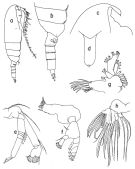 issued from : T. Park in Antarct. Res. Ser. Washington, 1983, 38 (3). [p.174, Fig.4]. Female: a, habitus (lateral right side); b, last thoracic segments and urosome (lateral right side); c, forehead (lateral); d, rostrum (anterior); e, A2; f, Md; g, Mx1; h, Mx2.
|
 issued from : T. Park in Antarct. Res. Ser. Washington, 1983, 38 (3). [p.175, Fig.5]. Female: a, Mxp; b, P1 (anterior); c, P2 (posterior); d, P3 (posterior); e, P4 (posterior); ef, P5 (anterior). Nota: Urosome about 34/100 length of prosome. Ventral margin of 2nd and 3rd metasomal segment produced posteriorly into a prominent, spiniform process.
|
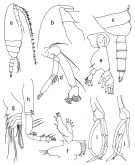 issued from : T. Park in Antarct. Res. Ser. Washington, 1983, 38 (3). [p.176, Fig.6]. Male: habitus (lateral right side); b, forehead (lateral); c, last thoracic segments and urosome (lateral right side); d, A2; e, Md (mandible palp); f, Mx1; g, Mx2; h, Mxp; i, P5 (right anterior)j, P5 (right side). Nota: 5th urosomal segment almost completely telescoped into 4th. Rostrum as in female.
|
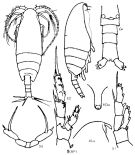 Issued from : K.A. Brodskii in Calanoida of the Far Eastern Seas and Polar Basin of the USSR. Opred. Fauna SSSR, 1950, 35 (Israel Program for Scientific Translations, Jerusalem, 1967) [p.267, Fig.177]. Female (from NW Pacif.): habitus (dorsal and lateral right side); forehead (lateral); RDo, rostrum (dorsal view); urosome (ventral); S1, P1; S2, P2: S5, P5. Nota: eye ruby red. Head and 1st pediger segment fused, 4th and 5th partly fused. Rostrum in sausage-shaped process with very thin and short terminal appendage. A1 23-segmented, reaching middle of genital segment; Mx1 bearing band-shaped and vermiform appendages but without sperical or brushlike tips. Posterior corners of 5th thoracic segment slightly acute, projecting slightly behind middle of genital segment. Abdomen 3-times in length of thorax. Caudal rami strongly diverging laterally, almost perpendicular to body axix., bristles thickened porximally, often asymmetrical.
|
 issued from : W. Vervoort in B.A.N.Z. Antarctic Reseach Expedition, Report Ser. B, Vol. III. 1957 [Fig.85]. As Racovitzanus erraticus. Male (from 61°44'S, 77°59'E): a, habitus (lateral); ; b-c, posterior part cephalothorax and urosome (lateral and dorsal, respectively); d, forehead (lateral).
|
 issued from : W. Vervoort in B.A.N.Z. Antarctic Reseach Expedition, Report Ser. B, Vol. III. 1957 [Fig.86]. As Racovitzanus erraticus. Male: a, left A2; b, right A1; c, cephalothorax (dorsal); d, Mxp; e, left Md (mandibular palp).
|
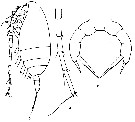 issued from : W. Vervoort in B.A.N.Z. Antarctic Reseach Expedition, Report Ser. B, Vol. III. 1957 [Fig.87]. As Racovitzanus erraticus. Male: a, right P1 (anterior); b, left P2 (posterior); c, right P3 (posterior); d, left P4 (posterior); e, P5 (rt = right leg; lt = lrft leg); f, right Mx1).
|
 issued from : R.N. Wolfenden in Die Marinen Copepoden der Deutschen Südpolar-Expedition 1901-1903, 1911. [p.260, Fig.36]. Female: a, P1; b, P2; c, P4; d-e, P5.
|
 issued from : R.N. Wolfenden in Die Marinen Copepoden der Deutschen Südpolar-Expedition 1901-1903, 1911. [Pl.XXX, Fig.6]. Female: 6, habitus (lateral).
|
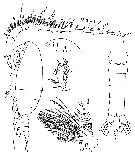 issued from : W. Giesbrecht in Copepoden. Res. voyage du S. Y. Belgica. Rapports scientifiques, Zoologie, 1902. [Taf. IV, Figs. 8-13]. Female (from S Peter Ist Island, Bellingshausen Sea): 8, habitus (lateral); 9, forehead (lateral); 10, utosome (ventral); 11, A1; 12, Mx1; 13, Mx2.
|
 issued from : W. Giesbrecht in Copepoden. Res. voyage du S. Y. Belgica. Rapports scientifiques, Zoologie, 1902. [Taf. V, Figs.1-5]. Female: 1-4, P1 to P4; 5, P5.
|
 issued from : N.A. Sedova & S.S. Grigoryev in Zool. Zh., 2010, 90 (3). [p.3, Fig.1]. Female (from Kamchatka): 1, habitus (lateral); 2, A1; 3, rostrum; 4, A2; 5, last thoracic segment and urosome (dorsal). Male: 6-7, habitus (dorsal and lateral, respectively); 8, A1. Scale bars: 0.5 mm (1, 2, 6, 7, 8); 0.2 mm (5); 0.1 mm (3, 4).
|
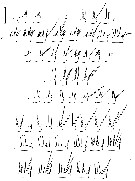 issued from : N.A. Sedova & S.S. Grigoryev in Zool. Zh., 2010, 90 (3). [p.4, Fig.2]. Female: armature variation on segments 1 to 8 of A1. Scale bar: 0.2 mm.
|
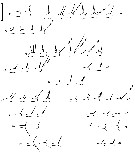 issued from : N.A. Sedova & S.S. Grigoryev in Zool. Zh., 2010, 90 (3). [p.5, Fig.3]. Female: armature variation on segments 9 to 23 of A1. Scale bar: 0.2 mm.
|
 issued from : N.A. Sedova & S.S. Grigoryev in Zool. Zh., 2010, 90 (3). [p.7, Fig.4]. Female: a, Mx1; other letters, armature variation on the 3rd inner lobe. Scale bar: 0.1 mm.
|
 issued from : N.A. Sedova & S.S. Grigoryev in Zool. Zh., 2010, 90 (3). [p.8, Fig.5]. Female: 1, 2, Mx2; 3, Md (mandibular palp); 4, Md (gnathobase); 5, Mxp; 6, distal segments of Mxp (variant); 7, P5. Male: 8, P5. Scale bars: 0.1 mm (1, 2, 3, 5, 6, 7, 8); 0.05 mm (4).
|
 issued from : N.A. Sedova & S.S. Grigoryev in Zool. Zh., 2010, 90 (3). [p.9, Fig.6]. Female: 1, P1, 3-4, anomaly on the 2nd exopodal segment; 2, P2: 5, spine anomaly on the exopodite of P2; 6, basis anomaly of P2; 7-13, endopod variation of P2; 14-21, endopod variation of P3. Scale bars: 0.1 mm (1, 3, 4, 6, 7-21; 0.2 mm (5); 0.05 mm (6).
|
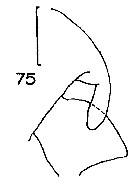 Issued from : J.M. Bradford in N.Z. Oceanogr. Inst., 1971, 206, Part 8, No 59. [p.22, Fig.75]. Male (from Ross Sea): 75, forehead (lateral). Scale bar: 100 µm.
|
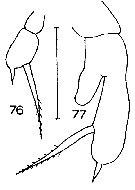 Issued from : J.M. Bradford in N.Z. Oceanogr. Inst., 1971, 206, Part 8, No 59. [p.22, Fig.76, 77]. Female (from Ross Sea): 76, P5: 77, P5 (another specimen). Scale bar: 100 µm. Nota: Both types of female P5 were recorded in the Ross Sea.
|
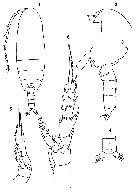 Issued from : O. Tanaka in Spec. Publs. Seto mar. biol. Lab., 10, 1960 [Pl. XVII, 1-6]. Female (from 66°59'S-67°03'S, 41°08'E-40°44'E): 1, habitus (dorsal); 2, forehead (lateral); 3, last thoracic segment and urosome (lateral); 4, anal segment and caudal rami (dorsal); 5, P1; 6, P2. same scale for 5 and 6. Nota: - Cephalothorax and abdomen in the proportional lengths 75 to 25. - Rostrum sausage-shaped. - Posterior thoracic margin rounded at the apex in lateral view, but in dorsal view the distal margin is pointed. - The line of fusion between the 4th thoracic segments is faintly visible from the dorsal. - Abdomen 4-segmented; the segments and caudal rami in the proportional lengths 33 : 14 : 14 : 24 15 = 100. - Genital segment produced below; receptacles in lateral aspect long and transversally located in the middle of the segment. - Genital, 2nd and 3rd urosomal segments striated with fine spinules on the distal margin. - A1 22-segmented, extends about to the 2nd thoracic segment; segments 8, 9 and 10 fused. - P5 2-segmented; 1st segment short, 2nd segment moderately long and furnished with a short apical spine and a long inner marginal seta haired on the distal half of its length. - Caudal rami divergent, with a small appendicular seta on the posterior surface of the ramus.
|
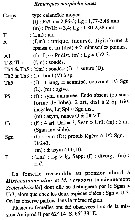 Issued from : C. Razouls in Ann. Inst. océanogr., Paris, 1994, 70 (1). [p.111]. Caractéristiques morphologiques de Racovitzanus antarcticus femelle et mâle adultes. Terminologie et abbréviations: voir à Calanus propinquus.
| | | | | Compl. Ref.: | | | Hardy & Gunther, 1935 (1936) (p.167, Rem.); Sewell, 1948 (p.570, 573, 574); Minoda, 1958 (p.253, Table 1, 2,abundance); Grice & Hulsemann, 1965 (p.223); Furuhashi, 1966 a (p.295, vertical distribution vs mixing Oyashio/Kuroshio region, Table 7); Fleminger, 1967 a (tabl.1); Shih & al., 1971 (p.152); Björnberg, 1973 (p.333, 388); Peterson & Miller, 1975 (p.642, 650, Table 3, as antarcticas, interannual abundance); 1976 (p.14, Table 1, 2, abundance vs interannual variations); 1977 (p.717, Table 1, seasonal occurrence); Mackas & Sefton, 1982 (p.1173, Table 1); Hopkins, 1985 (p.197, Table 1, gut contents); Zmijewska, 1987 (tab.2a); Hopkins & Torres, 1988 (tab.1); Atkinson & al., 1990 (p.1213, tab.1); Shih & Marhue, 1991 (tab.2, 3); Hattori, 1991 (tab.1, Appendix); Knox & al., 1996 (tab.1); Fransz & Gonzalez, 1997 (p.395, weight-length, biomass vs. N-S transect); Errhif & al., 1997 (p.422); Voronina & Kolosova, 1999 (p.71); Atkinson & Sinclair, 2000 (p.46, 50, 51, 54, 55, zonal distribution); Razouls & al., 2000 (p.343, tab. 5, Appendix); Yamaguchi & al., 2002 (p.1007, tab.1); Sedova & Grigoriev, 2005 (p.112); Kuriyama & Nishida, 2006 (p.299: Tab;II; p.309: Tab.III, fig.7, 10, vertical distribution); Hooff & Peterson, 2006 (p.2610); Schnack-Schiel & al., 2008 (p.1046: Tab.2); Ward & al., 2008 (p.241, Appendix II ); Galbraith, 2009 (pers. comm.); Park & Ferrari, 2009 (p.143, Table 4, 6: antarctic and boreal distribution, 7: common deepwater species, Appendix 1); Homma & Yamaguchi, 2010 (p.965, Table 2); Swadling & al., 2010 (p.887, Table 2, 3, A1, fig.6, abundance, indicator species); Homma & al., 2011 (p.29, Table 2, 3, abundance, feeding pattern: detritivores); Matsuno & al., 2012 (Table 2); Michels & al., 2012 (p.369, Table 1, occurrence frequency); in CalCOFI regional list (MDO, Nov. 2013; M. Ohman, comm. pers.); Ohashi & al., 2013 (p.44, Table 1, Rem.); Ojima & al., 2013 (p.1293, Table 2, 3, abundance); Lee D.B. & al., 2013 (p.1215, Table 1, abundance, composition); Eisner & al., 2013 (p.87, Table 3: abundance vs water structure). | | | | NZ: | 14 | | |
|
Distribution map of Racovitzanus antarcticus by geographical zones
|
| | | | | | | | |  Issued from : A. Atkinson & J.D. Sinclair in Polar Biol., 2000, 23. [p.50, Fig.3] Issued from : A. Atkinson & J.D. Sinclair in Polar Biol., 2000, 23. [p.50, Fig.3]
Racovitzanus antarcticus from Scotia Sea.
Median and interquartile ranges of copepods (nos /m2) in the five water zones; from north to south these are SAF Subantractic Front area, PFZ Polar frontal Zone, PF Polar Front area, AZ Antarctic Zone, WSC Weddell-Scotia Confluence area/ East Wind Drift.
Numbers on the plots are upper interquartiles where these could not be scaled. |
 Issued from : K.M. Swadling, So. Kawaguchi & G.W. Hosie in Deep-Sea Research II, 2010, 57. [p.898, Fig.6 (continued)]. Issued from : K.M. Swadling, So. Kawaguchi & G.W. Hosie in Deep-Sea Research II, 2010, 57. [p.898, Fig.6 (continued)].
Distribution of indicator species Racovitzanus antarcticus from the BROKE-West survey (southwest Indian Ocean) during January-February 2006.
Sampling with a RMT1 net (mesh aperture: 315 µm), oblque tow from the surface to 200 m.
The survey area was located predominantly within the seasonal ice zone, and in the month prior to the survey there was considerable ice coverage over the western section but none over the east.
See map showing sampling sites in Calanus propinquus. |
| | | | Loc: | | | Antarct. (Amundsen Sea, Croker Passage, Peninsula, Weddell Sea, SW & SE Atlant., Indian, Lützow-Holm Bay, Pacif., McMurdo Sound, Ross Sea, Bellinshausen Sea), South Georgia, sub-Antarct. (SW Atlant., Indian, SW & SE Pacif.), S Indian (subtropical convergence), South Africa, Brazil, NE Atlant. (30-60° N) (in Grice & Hulsemann, 1965), Japan, Sagami Bay, off Sanriku, off SE Hokkaido, Station Knot (44°N, 155°E), Australia (Great Barrier), New Zealand (off SW South Island)), Okhotsk Sea, Canada Basin (rare), Bering Sea, Aleutian Basin, S Aleutian Is., Kamchatka, off S Aleutian, Station "P" (50°N, 145°W), British Columbia, Vancouver Is., Oregon (Yaquina, off Newport), California, S Chile (sub-Antarct.) | | | | N: | 73 | | | | Lg.: | | | (6) F: 2,48-2,2; M: 2,28-2,08; (9) F: 2,28; 2,1; (10) F: 2,1; (25) F: 2,39-2,16; M: 2,03-1,98; (31) F: 2,4-2,1; (33) F: 2,3; (34) F: 1,88-1,77; M: 1,8; (35) F: 2,42-2,13; (66) F: 2,47-2,37; (102) F: 2,4; 2,2; M: 2; 1,7; (208) F: 2,3-2,2; (208') M: 2,06; (1000) F: 2,2 ± 0,1; {F: 1,77-2,48; M: 1,70-2,28} | | | | Rem.: | epi- to bathypelagic.
Sampling depth (Antarct., sub-Antarct.) : 0-800 m.
Distributional range (m) from Grice & Hulsemann (1965): 450-1000 (in Kuriyama & Nishida, 2006).
For Tanaka (1960, p.42) this species is one of the characteristic copepods of the Antarctic, it occurs sometimes in the north of the Antactic Convergence.
Localities not specified in the NE Atlantic (Grice & Hulsemann, 1965). Labeled samples losted (pers. comm.).
According to Farran (1929) this species would represent an indicator for the profound currents of Antarctic origin.
Brodsky indicates the coordinates: 42-55°N, 144-164°E and Kamchatka. Park (1983, p.177) had examined some female specimens from the Friday Harbor area (NE Pacific), and found them to agree in all anatomical detais with specimens from the Antarctic except for a seemingly minor difference (the inner seta of P1 basis barely reaches the distal end of the endopod in the former but extends beyond the distal end of the endopod by 1/2 its length in the latter).
According to Vervoort (1951, p.94), the new genus introduced by Giesbrecht for this species, is characterized by the curious cylindrical rostrum (a condition not found in any of the other genera of the Scolecittichidae). P5 feet, in Giesbrecht's female specimen, are symmetrical on both sides and consist each of a proximal, short segment and an elongate distal segment, more or less fused with the preceding segment and carrying a long, slightly haired internal seta and a much shorter, spiniform external seta; in Giesbrecht's specimen the inner edges of the proximal segments of both sides showed an elongate prolongation, representing a rudiment of the endopod; Wolfenden reports on the probable abnormal condition of Giesbrecht's specimen, as none of his specimens show a trace of such an endopod. The examination of Vervoort's specimens confirms Wolfenden's observations; about half the number of specimens from Antarctic has the P5 as figured and described by Giesbrecht, i.e. with rudimentary endopod; all remaining specimens show no trace of an endopod but vary slightly in the development of the exopod (distal segment); the jointing between distal and proximal segments is weakly indicated in some specimens and clearly marked in others, whilst many transitional stages occur; the length of the spines on the distal segment varies considerably (a peculiarity observed by Wolfenden). The majority of the specimens have short hairs along the outer edge of the apical spine; some specimens have a nude spine.
For Bradford (1971 b, p.23) suggests, because of the swimming leg spinulation pattern, that Vervoort (1957) has assigned male specimens incorrectly, one to antarcticus, the other to a new species, R. erraticus. In the Ross Sea 2 male specimens were captured which agree with R. erraticus Vervoort, 1957, but which are in fact males of R. antarcticus. A new name must therefore be given to Vervoort's (1957) male antarcticus which appears to differ from all other species of the genus by the large number of small spinules on P2 and P3 3rd exopodal segments, also in having ap1 external spine in the 1st exopodal segment.
After Sedova & Grigoryev (2011, p.11) the females from the eastern Okhotsk Sea and northeastern Pacific show variation of the shapes of cephalothorax and legs; particularly on the A1 (2 to 11 variants of setation on undividual segments); A2 (endopodite structure varied); Mx1 (setation of 3-4 protopodites lobes; the number of sensory setae on the endopodite); Mxp (the number of setae on individual segments); the P2 and P3 ( the number and position of spines on the rear of the endopodite, 7-8 variants). All variations were independant. The morphologies of males and females are generally similar.
After Bradford & al. (1983, p.93) Vervoort (1957) desctribes R. antarcticusR. erraticus)from purely Antactic localities, in deep and moderately deep water. This agrees with Brodsky's (1850 [1967] observations of R. antarcticus as a high-latitude bathypelagic species in the north-western Pacific, Bering Sea and Sea of Okhotsk. | | | Last update : 17/06/2021 | |
|
|
 Any use of this site for a publication will be mentioned with the following reference : Any use of this site for a publication will be mentioned with the following reference :
Razouls C., Desreumaux N., Kouwenberg J. and de Bovée F., 2005-2026. - Biodiversity of Marine Planktonic Copepods (morphology, geographical distribution and biological data). Sorbonne University, CNRS. Available at http://copepodes.obs-banyuls.fr/en [Accessed January 15, 2026] © copyright 2005-2026 Sorbonne University, CNRS
|
|
 |
 |



























